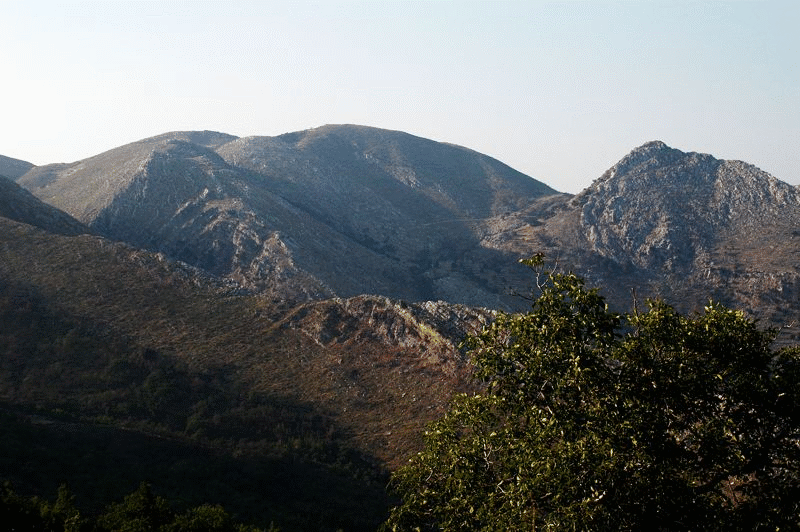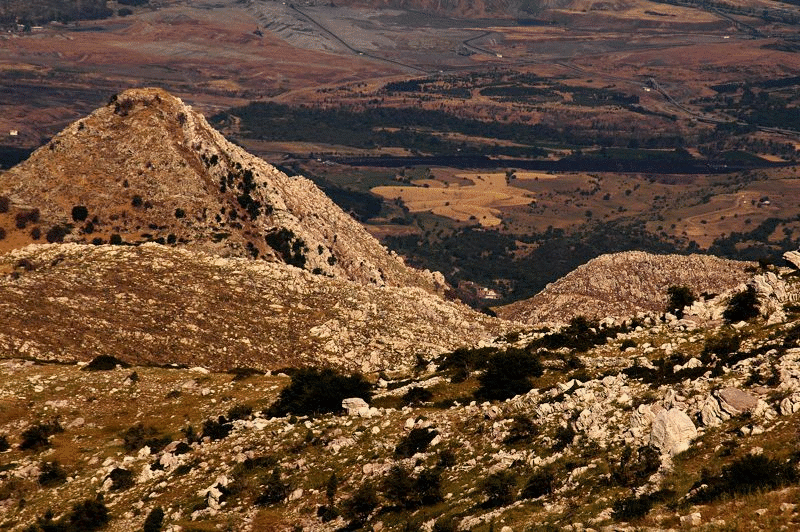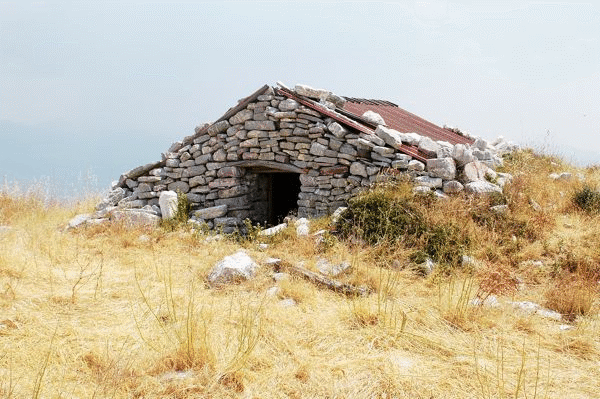Stop A.
Cross over to the north side of the road, looking carefully for cars that might be moving swiftly on this mountain road. The view to the north is parallel to the structural grain of the Pindos fold and thrust belt (Figure FT-4). This is a good vantage to gain a sense for the size and style of folding that dominates the structural geology of the eastern third of the map area, and to spot a trace of the Lykaion thrust in the far distance. Furthermore, from here we can begin to appreciate the landscape expressions of First Flysch Beds, Thin Platy Limestone Beds, and Thick White Limestone Beds. [Section VI of the companion paper describes “Stratigraphy Within The Sanctuary of Mt. Lykaion"].
Figure FT04. View from Stop A of major folding.

Photograph directed northward from Kastanochori. Limestone capping ridge in foreground is part of the Thick White Limestone Beds. The grass and brush-covered slope below and to the left is underlain by Thin Platy Limestone Beds. Further downslope is a burnt woods underlain by First Flysch Beds. In left background the Three Gorges anticline is clearly evident. On far right in background is the westward-overturned St. George anticline. In far center background is the hill in which the Lykaion thrust fault is exposed.
Spotting the trace of the Lykaion thrust from here will be important. It dips very gently eastward and is marked by stark contrast between dark rocks above and white rocks below (see Figure 26). Above this thrust is the Zeus thrust sheet. Below this thrust is the Pan thrust sheet. Almost all of the rocks that comprise this view from Stop A belong to the Pan thrust sheet. The Sanctuary of Zeus is not visible from here, nor is the St. Elijah klippe. [Section VII-B1 in companion paper covers “Overall Structural Relationships].
Consult the geologic map (see Figure FT-2) to note the locations and orientations of the five major fold structures in the eastern third of the study area, and the location of the Lykaion thrust fault. [Section VII-C1 in the companion papers covers “Overall Structural Relaions” in this eastern domain].
Looking north from Stop A, you will see a profile view of the Three Gorges anticline (see Figure FT-4). Furthermore, you will see the overturned western limb of the St. George anticline (see Figure FT-4). On its pointed summit is the tiny chapel to St. George (Figure FT-5). On the highest ridge in the distance is the trace of the Lykaion thrust fault, which here dips gently eastward (see Figure FT-4). The dark-colored hanging-wall rocks that you see there are primarily First Flysch Beds (i.e., brown sandstones). The white footwall rocks are Thick White Limestone Beds.
Figure FT05. View of peak on which St. George Chapel is located.

A. East-directed view of hill spire on top of which is located the Chapel of St. George.
This is a good place to begin to gain a sense for the landscape expression of some of the rock formations (see Figure FT-4). In the foreground, i.e., from the road down across the tree-covered slopes to the first major canyon, the landscape expression of First Flysch Beds is well displayed. In contrast, the stark bedrock landscapes in the middle and far distance are underlain by Thin Platy Limestone Beds and overlying Thick White Limestone Beds (see Figure FT-4). Thick White Limestone Beds is bright white and very resistant to erosion. Its expression is particularly pronounced on the highest ridges, cropping out in massive craggy layers. The bedrock on Agios Georgios is Thick White Limestone Beds. The large folds that are evident from this vista occupy the Hippodrome thrust sheet, which lies below the Lykaion thrust and the Lykaion klippe (see Figure FT-2).
Now head 1.2 km up the road to Stop B.
